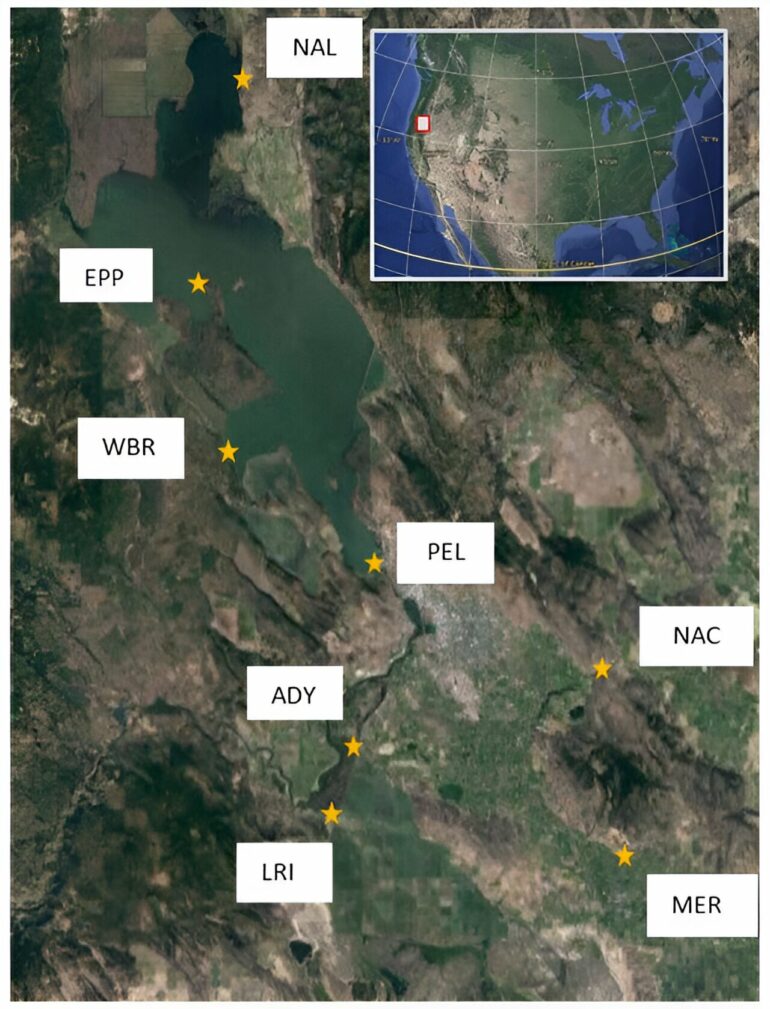Researchers at Oregon State University have developed a new way to monitor the danger associated with algae blooms: “sniffing” the water for gases associated with toxins.
The scientists found that certain combinations of volatile organic compounds (VOCs) released by algae can serve as indicator for microcystin, a toxin produced at varying levels during blooms of cyanobacteria, commonly known as blue-green algae.
Different cyanobacterial species produce different toxins, said OSU’s Kimberly Halsey, who led the study. Most of them cause gastrointestinal illness and acute skin rashes, and they can be deadly. In 2017, more than 30 cattle died after drinking contaminated water at Junipers Reservoir near Lakeview, Oregon, and blooms particularly pose a threat to dogs entering affected lakes.
Even though the research dealt with just one lake and one toxin, the research demonstrates VOCs’ potential in monitoring critical waterways, said Halsey, associate professor of microbiology in the College of Science.
She said the study published today in mSystems describes “a very creative new approach that’s better and less expensive than current monitoring methods and also has broader implications.”
“This work suggests that VOCs might be used to indicate other important environmental shifts, like the onset of oxygen deficiencies in aquatic systems or domoic acid contamination in coastal ecosystems,” Halsey said.
Further research, including collaborations with the city of Salem and Eugene Water and Electric Board, will explore whether the gaseous molecules can be used to predict the start and end of toxicity within a bloom event.
VOCs are any of a number of carbon-containing chemicals with a high tendency to exist in their gaseous state. VOCs released by cyanobacteria seem to reveal the physiological status of the algae during toxic blooms, Halsey said.
“One reason VOCs could be such great targets for monitoring is their volatility,” she said. “Ideally we’ll someday be able to sniff the air above the lake with instruments and see which gases are there during cyanobacterial blooms.”
Cyanobacteria are microscopic organisms ubiquitous in all types of water around the globe. They use sunlight to make their own food and in warm, nutrient-rich environments can quickly multiply, resulting in blooms that spread across the water’s surface.
These harmful algal blooms, often abbreviated to HABs, can form at any time of the year, but most typically happen between spring and fall.
An HAB in 2018 fouled drinking water in Oregon’s capital city of Salem, and in 2007 a national survey by the U.S. Environmental Protection Agency found microcystin, a recognized liver toxin and potential liver carcinogen, in one out of every three lakes that were sampled.
Annual economic losses attributed to cyanobacterial HABs in the United States alone are conservatively valued at between $2 billion and $4 billion, say the researchers, who add that the severity and consequences of the blooms are likely to be exacerbated by climate change.
“That means we need new and innovative monitoring for cyanobacteria and their toxins,” Halsey said. “It’s super expensive to measure toxins directly, especially when a waterway needs to be sampled and tested weekly over the course of an entire summer.”
Halsey, microbiology graduate student Lindsay Collart and associate professor of statistics Duo Jiang worked with two years of water samples from eight locations on and near Upper Klamath Lake in southern Oregon.
The lake is important for agriculture and recreation, for tribal subsistence and culture, and for fish and wildlife, Halsey notes, but its water quality has declined over the last 50 years from intensive farming and drought.
Upper Klamath Lake is one of many Oregon lakes affected by cyanobacterial HABs each year, but not all of the blooms result in toxic levels of microcystin, and the onset and levels of toxin production have been largely unpredictable.
“The algae cells are always producing a little bit of microcystin, and it serves a good purpose in the cell—it helps combat stress,” Halsey said. “But the cells can reach a tipping point of over-reliance on microcystin and that’s when levels in the water become toxic.”
Analyzing the dissolved gases in the water samples—227 VOCs in all—the scientists were able to determine subsets of them that were associated with different levels of microcystin in the water. Statistical analysis of the VOC subsets does a better job predicting toxin levels than currently used techniques like assessing water color and measuring cell count, Halsey said.
“Now that we know these particular subsets of compounds are predictors of toxicity, maybe we only need to measure those,” she said.
Even though the study dealt with just one lake and one toxin, the research demonstrates VOCs’ potential in monitoring critical waterways, Halsey said. Further research, including collaborations with the city of Salem and Eugene Water and Electric Board, will explore whether the gaseous molecules can be used to predict the start and end of toxicity within a bloom event.
Halsey said the study also showed that VOCs can be used to paint a general picture of community composition—i.e., the relative abundance of cyanobacteria to other microbes in the system—which she describes as potentially “another piece of the prediction puzzle.”
More information:
Lindsay Collart et al, The volatilome reveals microcystin concentration, microbial composition, and oxidative stress in a critical Oregon freshwater lake, mSystems (2023). DOI: 10.1128/msystems.00379-23
Provided by
Oregon State University
Citation:
Researchers develop novel technique for sniffing out toxic algae blooms (2023, August 17)



